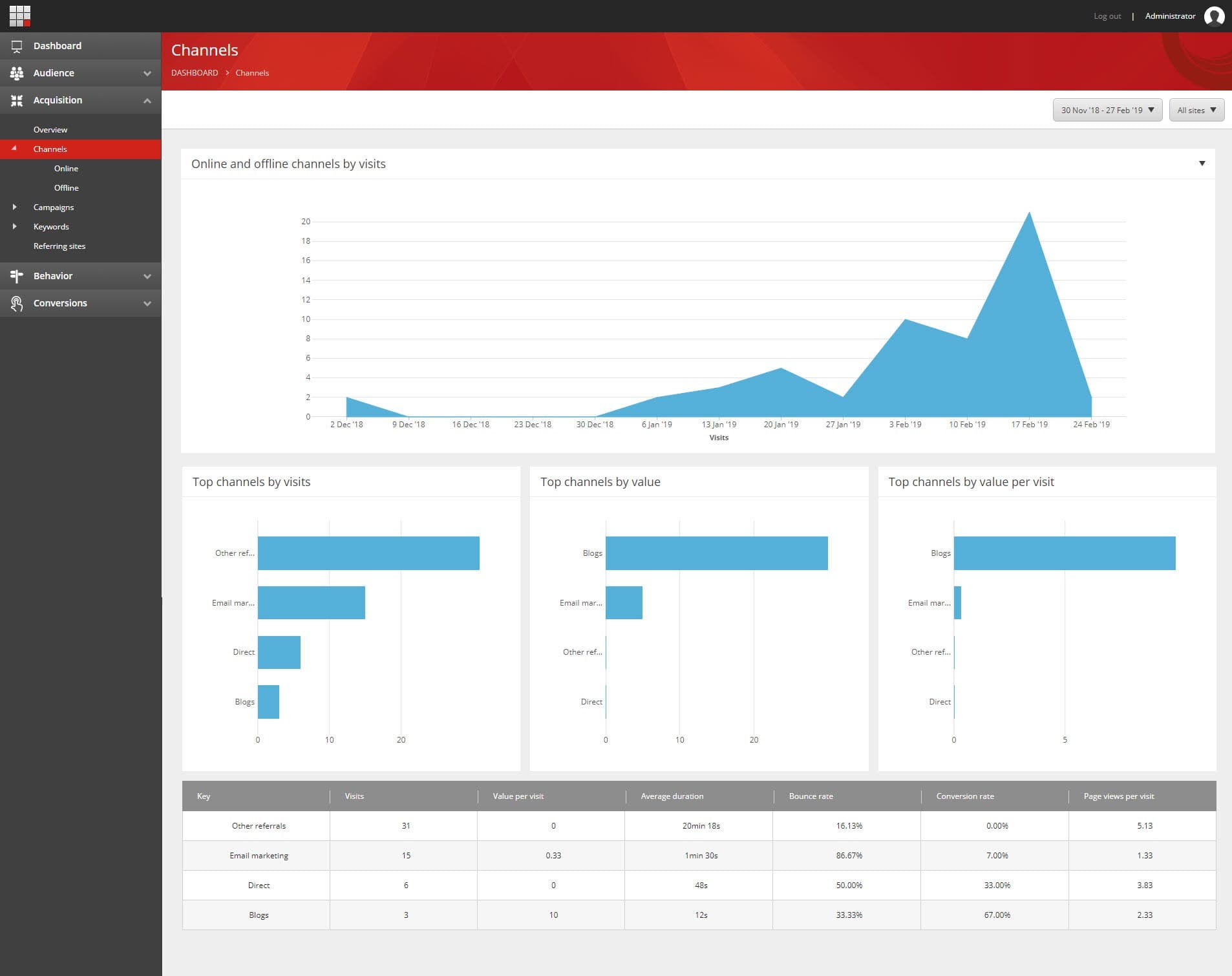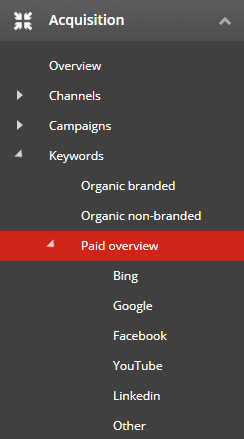

Oct 10, 2019
Sitecore’s campaign manager helps you organize your marketing activities into an effective strategy that you can track, monitor, and adjust based on the outcomes you’re seeing.
It’s very likely that you are already tracking your campaigns using Google Analytics or some other tool. That data is great for evaluating campaign performance, but the data gathered by Sitecore enables you to also personalize your visitor’s experience on your website and more efficiently drive them toward conversion.
Implementing a Sitecore campaign is a seven-step process:
- Identify campaign groups
- Define campaign facets
- Refine channels
- Classify assets
- Create content
- Build URL
- Run campaign
In this post, I will focus on the first three steps, since those are the ones that relate to classifying your campaigns. My goal is to help you understand the why and how behind Sitecore’s campaign taxonomy. So let’s start by answering the obvious question...
Why should I care?
Defining a taxonomy will help you better organize and report on your campaigns. Classifications will act as tags to allow you to better analyze the effectiveness of each campaign.
Three basic types of campaign taxonomies within Sitecore are Campaign Groups, Campaign Facets, and Channels.
Your website visitors arriving via your campaigns will have their interactions recorded in xDB. You’ll see your campaigns’ info on the Acquisition tab reports: Campaigns, Groups and Campaign facets.
Campaigns that do not have a Campaign Group defined will be shown on the Experience Analytics reports grouped under the “unknown campaign group”.

The definition of the campaign attribute Channel will feed Channels reports. This report will remain empty until you start associating a channel to your campaign activities.

Paid overview reports will also be populated based on the campaigns you define (if any) to keep track of your paid keywords.

So, defining a taxonomy for campaigns will impact how their associated data is aggregated and presented in your Experience Analytics reports. That's the why, but how do you do it? Let's find out...
-
Identifying Campaign Groups
In this first step, you will identify the groups that will be used to aggregate your campaign data in Experience Analytics reports. The campaign group functions as a tag to identify campaign activities that belong to the particular campaign group.
According to Sitecore’s documentation: “A campaign group is a higher-level campaign that contains multiple campaign activities. You can use campaign groups to group individual campaign activities that you run across different channels.”
Evaluating the performance of your campaign activities across channels is a key piece of information to decide how to allocate your resources in future campaigns. You might decide to spend more on channels that have a better conversion rate or perhaps adjust your tone, voice and messaging in that specific channel next time.
It is recommended that you group your campaigns by their intent, theme, goal. For example, a campaign group could encompass a collection of activities that promote an event. The following table shows some examples of campaign groups for organizations in different business areas:
Business Area Group Description Retail Christmas Intended to group campaign activities designed to promote Christmas seasonal products. High-end Gathers campaign activities implemented to highlight expensive and unique products. Semi annual sale Groups semi annual sale promotions. Technology Symposium Aggregates campaign activities that will be run to promote the event. Homework for Step 1:
Write down at least two or three groups you feel your organization run campaigns around. Think of groups for either past or future campaigns.
Follow the steps in the documentation to create your campaign groups in Sitecore.
-
Defining Campaign Facets
Facets will describe aspects of your campaigns that are appropriate for your company and industry. Custom factors such as campaign iteration, campaign geography, campaign target audience or business unit/branch can be defined as campaign facets.
This is a tool that Sitecore provides you to be able to create a custom taxonomy to tag your campaign activities so that you can identify and track relationships between them.
In this step, you will dive into your organization’s campaigns and identify aspects that describe them.
For example, a real estate company that operates in multiple regions of the US could use such regions as a facet.
Campaign Facet Definition Group Tag Region Geographic areas used to design campaigns intended to target a specific region audience Southern California Inland Empire Orange County Texas Austin San Antonio Homework for Step 2:
In order to identify your marketing campaign facets, create a table where you can identify campaign facets, their definition, and the associated groups and tags.
Follow the steps in the documentation to edit campaign facets in Sitecore.
-
Reviewing Channels
When viewing how contacts interact with your website, it can be helpful to track which channels contacts use to come to your website. This can give you more insight into how contacts interact with your brand, which channels bring the most traffic to your campaigns, and which channels lead to the best goal conversion rates.
There are two basic types of channels you use to interact with contacts:
- Online channels – for example, PPC advertisements, a branded mobile application, social media references, and organic searches.
- Offline channels – for example, trade shows, direct marketing through the mail, meetings with customers, and conversations with customer service agents over the phone.
The Marketing Control Panel includes many different types of online and offline channels to help you identify incoming traffic to your campaigns. You can also create your own channel groups and types, which can help you better address your organization's specific marketing needs.
In this third step, you will go over the extensive list of online and offline channels provided by Sitecore out of the box. In case you are missing any channels, you must identify them so that they can be added to your marketing control panel taxonomy.
Homework for Step 3:
Review Sitecore's predefined channel groups and channels. Write down any groups and channels you think are missing.
Offline
Channel Group Channel Advertising Advertising Agency fee Broadcast advertising Corporate sponsorship Other advertising Out of home advertising Print advertising Call Center General inquiry Other call center Direct Marketing Direct mail - print or collateral Other direct marketing Events Customer events hospitality Industry event sponsorship Other event Trade shows Partner Marketing Other partner marketing Partner enablement Partner events Partner lead generation PR Other PR PR agency fee PR events Resources Corporate and product branding Giveaways Other resources Printed materials Product materials Sales Cold calling Customer meeting Inbound phone call Other sales Qualification call Telenurture Store Enter store Other store Telemarketing Other telemarketing Telemarketing Online
Channel Group Channel Organic Search Search organic branded Search organic non-branded Search not provided (Home page) Search not provided (not home page) Paid search advertising Bing ads Google ad LinkedIn ad YouTube ad Other ad Display Advertising LinkedIn Facebook Google Display Network Other Display Referrals PR Referrals Affiliate Referrals Partner Referrals RSS Other Referrals Email Campaigns Email Newsletter Email Marketing Email Notifications Email Purchased List Emails Sent Other Email SMS Campaigns SMS Marketing SMS Notifications SMS Sent Other SMS Automation Programs Email Automation SMS Automation Other Automation Apps App Store Activity App Push App Usage Other Apps Social Mentions Blogs Wiki Other Social Mentions Social Community Google Plus Social Community YouTube Social Community LinkedIn Social Community Facebook Social Community Twitter Social Community Other Social Community Social Sponsored Posts LinkedIn Sponsored Posts Facebook Sponsored Posts Twitter Sponsored Posts Other Sponsored Posts Digital Events Webinar Live Webinar Recorded Other Digital Events 3rd Party Virtual Events Email Inclusion Other 3rd Party Pay-Per-Lead Other 3rd Party
Final Thoughts
Completing the homework suggested on each one of the previous steps will get you one step closer to benefiting from the amazing capabilities your Sitecore platform offers.
Campaign groups, channels, and custom facets will work as tags to tie together your campaign activities analytics.
Maybe this is one of those parts of the platform you don't fully understand and don't touch because you are afraid of breaking something. Don't be! feel free to contact us if you'd like to learn more about how all the pieces fit together and how to make the most of your xMarketing tools within Sitecore.







